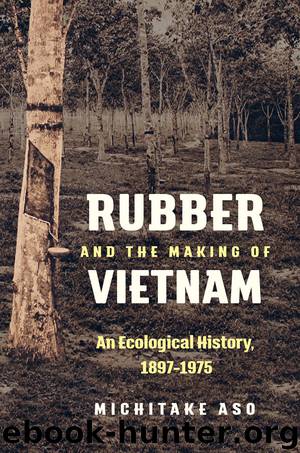Rubber and the Making of Vietnam by Aso Michitake;

Author:Aso, Michitake;
Language: eng
Format: epub
Publisher: University of North Carolina Press
New Directions in Plantation Labor
In July 1958, Ngô Đình Diệm, then president of South Vietnam, went on an inspection tour of the plantations of the SPTR, Lai Khê (a rubber research center), and Michelin’s Dầu Tiếng plantation. On his tour, Diệm commented positively on the new coagulation techniques and the use of Caterpillar tractors for deforestation. Diệm’s tour was meant to publicize a rubber loan program that was ostensibly aimed at encouraging Vietnamese to enter the industry, yet ended up funding large French-owned plantations. Why was Diệm, an ardent nationalist, offering support for French-controlled institutions and businesses? How did the rubber industry fit into Diệm’s projects of state and nation making? What strategies did other state officials, planters, workers, and communist insurgents adopt to make the best use of plantations? Only two weeks after Diệm’s visit, roughly 400 members of a communist force caused considerable damage during an attack on the Dầu Tiếng plantation. This communist attack indicates the ongoing struggles over plantation space.7
During Ngô Đình Diệm’s First Republic, rubber plantations remained the dominant, if controversial, models of labor and health in the red earth region. This was partly due to the pivotal role plantations played in resettling thousands of northern migrants. In early July 1954, Diệm formed his government and on July 21 signed the Geneva Accords, creating a divided Việt Nam. As part of the Accords, DRV and South Vietnamese representatives agreed to allow people to move freely between the north and the south for 300 days. During this period of “regrouping” (di cư và tập kết), intense efforts were made on both sides to influence population movements. Beginning in August, thousands of Vietnamese Catholics moved from the north to the south and DRV cadre and troops moved from the south to the north.8 Plantation holdings confiscated from defeated opponents provided Diệm with a means to deal with the massive influx of refugees into the RVN. For example, an RVN-controlled plantation near Củ Chi, which was formerly owned by Lê Văn Viễn, or Bảy Viễn, temporarily housed 8,000 refugees in 1956.9
Diệm was not concerned with labor and health conditions on plantations when he arrived in southern Việt Nam during the middle of 1954; rubber workers, however, advanced their agenda through strikes that began in October of that year. After the First Indochina War, the labor movement split into many unions, with some focused solely on advancing workers’ rights while others viewed their activism as part of the socialist revolution. Regardless of their political leanings, rubber workers made several demands on their employers: build schools for their children, reduce the number of trees tapped, distribute white rice instead of brown, decrease the number of working hours, provide promised clothing, and increase bonuses and wages. In a letter dated December 10, 1954, Nguyễn Tăng Nguyên, the minister of labor and youth, criticized the workers who were striking without seeking arbitration, but he reserved his harshest words for the French directors. He stated that salaries were low and that many of
Download
This site does not store any files on its server. We only index and link to content provided by other sites. Please contact the content providers to delete copyright contents if any and email us, we'll remove relevant links or contents immediately.
| Fisheries & Aquaculture | Forests & Forestry |
The Lonely City by Olivia Laing(4546)
Animal Frequency by Melissa Alvarez(4130)
All Creatures Great and Small by James Herriot(3959)
Walking by Henry David Thoreau(3664)
Exit West by Mohsin Hamid(3615)
Origin Story: A Big History of Everything by David Christian(3455)
COSMOS by Carl Sagan(3322)
How to Read Water: Clues and Patterns from Puddles to the Sea (Natural Navigation) by Tristan Gooley(3215)
How to Do Nothing by Jenny Odell(3085)
The Inner Life of Animals by Peter Wohlleben(3082)
Hedgerow by John Wright(3071)
How to Read Nature by Tristan Gooley(3055)
Project Animal Farm: An Accidental Journey into the Secret World of Farming and the Truth About Our Food by Sonia Faruqi(2992)
Origin Story by David Christian(2971)
Water by Ian Miller(2940)
A Forest Journey by John Perlin(2889)
The Plant Messiah by Carlos Magdalena(2735)
A Wilder Time by William E. Glassley(2666)
Forests: A Very Short Introduction by Jaboury Ghazoul(2655)
